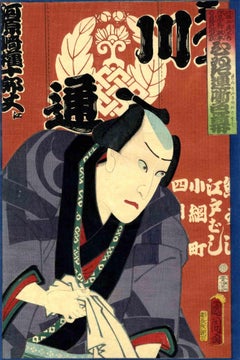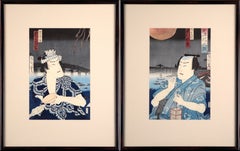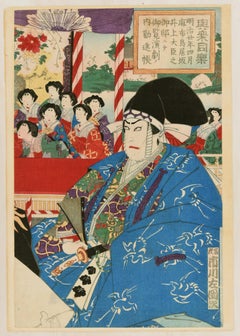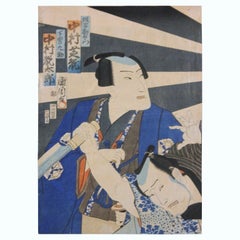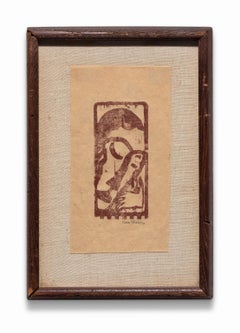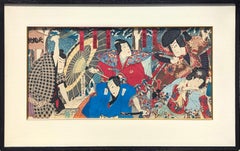Kunichika Toyohara Figurative Prints
Japanese, 1835-1900
Kunichika Toyohara was born as Ōshima Yasohachi in 1835. Toyohara was one of the last Japanese Ukiyo-e painters. His first signed print is from 1852, but it was only in 1854 that he took the stage name Kunichika. Toyohara is best known for his prints of Kabuki actors, using the woodblock technique. He also painted beautiful women and for some special occasions, historical scenes. Toyohara was certainly a brilliant painter with unmistakable talent and dissipated life.
to
2
3
1
Overall Width
to
Overall Height
to
1
4
855
382
379
308
4
3
1
4
4
2
2
1
1
1
1
1
1
1
1
4
1
1
1
2
2
1
Artist: Kunichika Toyohara
Portrait of the Actor Kawarazaki Gonjuro and Curtain by Kunichika Toyohara-1864
By Kunichika Toyohara
Located in Roma, IT
Portrait of the actor Kawarazaki Gonjuro and curtain is an original artwork realized in 1864 by Toyohara Kunichika (30 June 1835 – 1 July 1900)
Oban.
Bust portrait of the actor Kawarazaki Gonjuro in front of the brown theatre curtain with advertisement for the theatre performances.
Signed: Kunichika ga.
Publisher: Tsujiokaya Bunsuke. Censored by Aratame.
Excellent impression with blind printing and very fine visible vertical wood grain in the brown curtain and haori, glossy black print (collar), a little bit creased.
Toyohara Kunichika (30 June 1835 – 1 July 1900) was a ukiyo-e Japanese woodblock print artist. Talented as a child, at about thirteen he became a student of Tokyo's then-leading print maker, Utagawa Kunisada. His deep appreciation and knowledge of kabuki drama...
Category
1860s Modern Kunichika Toyohara Figurative Prints
Materials
Woodcut
Two Samurai Fighting with a Stick - Woodcut by Kunichika Toyohara
By Kunichika Toyohara
Located in Roma, IT
Two Samurai Fighting with a Stick is a Japanese multi-colored print realized around the end of the XIX Century by Toyohara Kunichika (Edo period, 1835 - 1900).
Original Woodcut on p...
Category
1880s Kunichika Toyohara Figurative Prints
Materials
Woodcut
Kabuki Actor Diptych, Late 19th Century Figural Japanese Woodblock Prints (Pair)
By Kunichika Toyohara
Located in Soquel, CA
Beautiful late 19th century Japanese woodblock print diptych of two kabuki actors by Kunichika Toyohara (Japanese, 1835-1900). This pair of prints is united by a continuous landscape...
Category
1870s Edo Kunichika Toyohara Figurative Prints
Materials
Paper, Ink, Woodcut
Kabuki Scene from "Kanjincho" - Woodcut by 1887 ca.
By Kunichika Toyohara
Located in Roma, IT
A scene from the important representation of Tenno Kabuki's Play "Kanjincho", held during the Meiji Era in the House of Minister Kaoru Inoue at the presence of the Emperor Akinori Aki and of the Princess Akira Terada. Attributed to the Ukiyo-e Master Kinichika Toyohara (Oshima Yasohachi), specialised in the representations of Kabuki Scenes on Woodcut blocks...
Category
1820s Kunichika Toyohara Figurative Prints
Materials
Woodcut
Related Items
Two Kabuki Actors Japanese Woodblock Print
By Toyohara Kunichika
Located in Houston, TX
Two kabuki actors posing a samurai's. The print is printed on rice paper and is not framed. It is stamped by the artist with details about the actors in ...
Category
1860s Edo Kunichika Toyohara Figurative Prints
Materials
Woodcut
Max Weber Woodcut Print from "Primitives" Poetry Book Signed
By Max Weber
Located in Detroit, MI
ONE WEEK ONLY SALE
This woodcut print is an expressionist print on one of the poems from Max Weber's poetry collection "Primitives: Poems and Woodcuts". This work is signed in penci...
Category
1920s Expressionist Kunichika Toyohara Figurative Prints
Materials
Woodcut
Japanese Beauties Enjoy a Full Moon
By Utagawa Kunisada (Toyokuni III)
Located in Burbank, CA
"Sun, Moon and Stars". Three beauties enjoy a full moon on the veranda of a teahouse or restuarant. The woman on the left kneels and adjusts her lavishly printed kimono. The beauty in the center has her hair down, and behind her is a screen against which shadows are beautifully silhouetted, which adds an air of mystery. The seated woman on the right is perhaps a geisha, as we see a shamisen lying next to her. Before her is a tray with an assortment of foods. One may surmise that the beauties are being compared to the sun, the moon, and the stars. On the left we glimpse a full moon shining over the peaceful bay, and boats at harbor. Original first edition Japanese color woodblock print triptych...
Category
1840s Edo Kunichika Toyohara Figurative Prints
Materials
Mulberry Paper, Woodcut
$3,600
H 14.18 in W 29.06 in
Untitled
By Kiki Smith
Located in New York, NY
Kiki Smith
'Untitled,' 1995
Woodcut with color additions by hand
31 x 21 inches
Edition 43 of 47
Signed
In 1995 five well-known American artists - Donald Baechler, Julian Lethbridge...
Category
1990s Kunichika Toyohara Figurative Prints
Materials
Woodcut
19th century color woodcut Japanese ukiyo-e print female geisha figure signed
By Utagawa Kuniyoshi
Located in Milwaukee, WI
This print is from a highly regarded series by the Edo woodblock artist Utagawa Kuniyoshi: in the period, there were at times prohibitions in depicting a...
Category
1850s Edo Kunichika Toyohara Figurative Prints
Materials
Pigment, Paper, Woodcut
Utagawa Kuniyoshi19th century color woodcut Japanese ukiyo-e print female geisha figure signed, 1852
$3,200 Sale Price
20% Off
H 21.5 in W 17.5 in
Wedding Party
Located in Buffalo, NY
An original mid century modern woodblock print.
This work is hand signed illegibly and titled "Wedding Party".
Category
1960s Modern Kunichika Toyohara Figurative Prints
Materials
Paper, Woodcut
Seishi Ai-oi Genji – Set of 12 Shunga works together w/astrological commentary
By Utagawa Kunisada (Toyokuni III)
Located in Middletown, NY
Set of 12 woodblock prints in colors on handmade, laid mulberry paper, 6 3/4 x 10 1/4 inches (170 x 258 mm), printed in Ka-ei 4 (1851). Each print with minor handling wear, otherwise in excellent condition with bright and fresh color, and with details printed in silver ink. The images themselves contain several illusive characters indicating the publisher which are obfuscated by figures, as intended. Presented loose, as issued. A fine set.
The astrological commentary print has a large and meandering blind stamp with a bird and palm frond motif. This print lists various phrases concerning the Twelve Zodiac Animals as historically counted in Japan, and appears to include erotic commentary on the traits of people born under each of the twelve signs.
These Shunga images were issued in books that paralleled (in an erotic fashion...
Category
Mid-19th Century Edo Kunichika Toyohara Figurative Prints
Materials
Handmade Paper, Ink, Woodcut
Black Horse
By Tokuriki Tomikichiro
Located in Middletown, NY
circa 1950.
Woodblock print in black and gray ink on Japon laid paper, 10 1/4 x 15 3/4 inches (260 x 398 mm), full margins. With the artist's embossed chop mark in red ink in the l...
Category
Mid-20th Century Edo Kunichika Toyohara Figurative Prints
Materials
Handmade Paper, Woodcut
Peace
By Anton Refregier
Located in Fairlawn, OH
Peace
Woodcut printed in orange red ink on japanese paper
Signed and titled in pencil lower right (see photo)
Titled lower left (see photo)
Created along with an illustrated book project Song of Peace, 1950-1959.
Condition: Excellent
Image: 10 1/2 x 4 7/8"
Sheet: 16 1/8 x 7";
Anton Refregier (March 20, 1905 – October 10, 1979) was a painter and muralist active in Works Progress Administration Federal Art Project commissions, and in teaching art. He was a Russian immigrant to the United States.
Among his best-known works is his mural series The History of San Francisco, located in the Rincon Center in downtown San Francisco, California. It depicts the city's history across twenty seven panels that he painted from 1940 to 1948.
Life and early career
Refregier was born in Moscow and emigrated to the United States in 1920. After working various odd jobs in New York City, he earned a scholarship to the Rhode Island School of Design in 1921. After finishing school, Refregier moved back to New York in 1925. To earn a living, Refregier worked for interior decorators, creating replicas of François Boucher and Jean-Honoré Fragonard paintings...
Category
1950s American Modern Kunichika Toyohara Figurative Prints
Materials
Woodcut
No Footprints Show, Where the Flowers Grow Deep
By Shiko Munakata
Located in Fairlawn, OH
No Footprints Show, Where the Flowers Grow Deep
Woodcut, 1961
Unsigned (as isssued)
From: The "Way" of the Woodcut, three woodcuts, 1961
Publisher: Pratt Adlib Press, Brooklyn, New Y...
Category
1960s Modern Kunichika Toyohara Figurative Prints
Materials
Woodcut
'Tokaido' — Mt. Fuji Rising – Mid-Nineteenth Century Woodblock Print
By Utagawa Kunisada (Toyokuni III)
Located in Myrtle Beach, SC
Utagawa Kunisada (Tokoyuni III), 'Tokaido', color woodblock, 1863. Signed in the cartouche, lower right. A fine impression, with rich, fresh colors and pronounced woodgrain, the full...
Category
1860s Edo Kunichika Toyohara Figurative Prints
Materials
Woodcut
The Lonely House at Asajigahara.
Located in Middletown, NY
A scene from a series of ghost stories and spooky rural legends.
Tokyo: Matsuki Heikichi, 1896.
Woodcut in ink with embossing and hand-coloring in watercolor on handmade mulberry pa...
Category
Late 19th Century Edo Kunichika Toyohara Figurative Prints
Materials
Watercolor, Handmade Paper, Woodcut
Previously Available Items
Colorful Dynamic Edo Period Kabuki Play Yakusha-e Woodblock Print Triptych
By Kunichika Toyohara
Located in Houston, TX
Colorful woodblock print by Japanese artist Toyohara Kunichika. The work features elaborately dressed kabuki actors in the middle of a dynamic scene. Currently hung in a black frame with a light cream matting and gold accents.
Dimensions Without Frame: H 13.5 in. x W 27.25 in.
Artist Biography: Toyohara Kunichika (June 30, 1835 - July 1, 1900) was a Japanese woodblock print artist. Talented as a child, at about thirteen he became a student of Tokyo's then-leading print maker, Utagawa Kunisada. His deep appreciation and knowledge of kabuki drama...
Category
19th Century Edo Kunichika Toyohara Figurative Prints
Materials
Woodcut
H 22.38 in W 35.25 in D 1.5 in
Kunichika Toyohara figurative prints for sale on 1stDibs.
Find a wide variety of authentic Kunichika Toyohara figurative prints available for sale on 1stDibs. You can also browse by medium to find art by Kunichika Toyohara in woodcut print, ink, paper and more. Much of the original work by this artist or collective was created during the 19th century and is mostly associated with the modern style. Not every interior allows for large Kunichika Toyohara figurative prints, so small editions measuring 10 inches across are available. Customers who are interested in this artist might also find the work of Utagawa Hiroshige (Ando Hiroshige), Toyohara Kunichika, and Utagawa Kunisada (Toyokuni III). Kunichika Toyohara figurative prints prices can differ depending upon medium, time period and other attributes. On 1stDibs, the price for these items starts at $507 and tops out at $2,092, while the average work can sell for $750.
